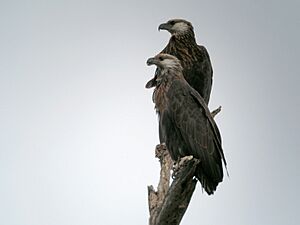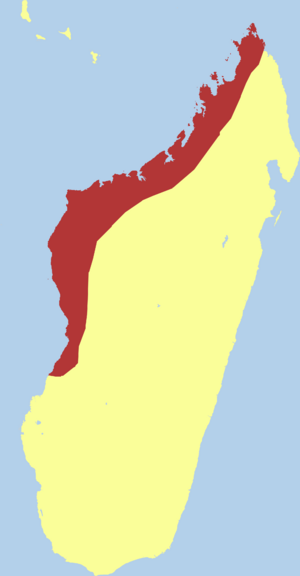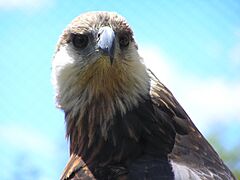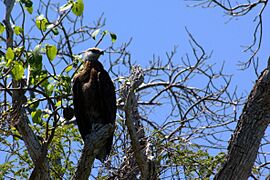Madagascar fish eagle facts for kids
Quick facts for kids Madagascar fish eagle |
|
|---|---|
 |
|
| Two at Lake Ravelobe, Ankarafantsika National Park | |
| Conservation status | |
| Scientific classification | |
| Genus: |
Icthyophaga
|
| Species: |
vociferoides
|
 |
|
| Range | |
The Madagascar fish eagle (Icthyophaga vociferoides), also known as the Madagascar sea-eagle, is a large bird of prey. It belongs to the Accipitridae family. This family includes other birds like kites, buzzards, and harriers. This special eagle only lives in the coastal areas of northwest Madagascar.
It's about 63 cm (25 in) long. It has a light brown head, a dark brown body, and a white tail. Sadly, the Madagascar fish eagle's numbers are shrinking. It is threatened by habitat destruction and people hunting it. The International Union for Conservation of Nature says it is "critically endangered". This means it's in great danger of disappearing forever.
About the Madagascar Fish Eagle
The Madagascar fish eagle is a medium-sized sea eagle. It grows to be about 60 to 66 cm (24 to 26 in) long. Its wings can spread wide, from 165 to 180 cm (65 to 71 in).
Its body and wings are dark brown. Its head is a pale brown, and its tail is white. The eagle's beak is blackish with a lighter part at the bottom. Its legs are pale grey. Male eagles weigh about 2.2 to 2.6 kg (4.9 to 5.7 lb). Females are a bit bigger, weighing 2.8 to 3.5 kg (6.2 to 7.7 lb).
This eagle's closest relative is the African fish eagle. They are like a special pair of sea-eagles. They both have dark beaks, talons (claws), and eyes. Unlike some other sea-eagles, they always have at least a partly white tail. One of these eagles (the Madagascan fish eagle) has a tan-colored head. The other (the African fish eagle) has a white head.
Where the Eagle Lives
This species lives only in Madagascar. You can find it in small numbers along the northwest coast. Its home is within the Madagascar dry deciduous forests.
A main place where these eagles live is the Analova region. In the 1980s, about 20 to 25 pairs of eagles were nesting there. More recently, some experts found at least three nesting pairs in the Anjajavy Forest. This forest is along the Indian Ocean, near Anjajavy Village.
Why It's in Danger
Experts believe there are only about 40 breeding pairs of these eagles left in the world. Some even say it might be one of the rarest birds on Earth. Other studies found at least 222 adult eagles from 105 different places. They estimated there were about 98 breeding pairs.
The biggest problems for their homes are deforestation (cutting down trees) and soil erosion. This happens when soil washes away. Also, wetlands where they live are being changed into rice paddies for farming.
These eagles also compete with people for fish. People need fish to eat, and so do the eagles. Because their numbers are going down and they face many threats, the International Union for Conservation of Nature has called this bird "critically endangered". This means it needs a lot of help to survive.
Gallery
-
At Tsimbazaza Zoo, Antananarivo




